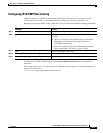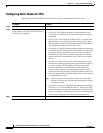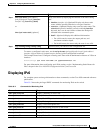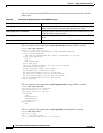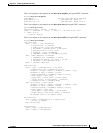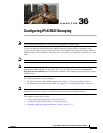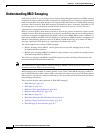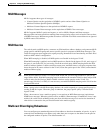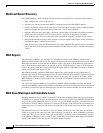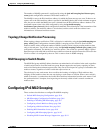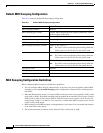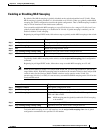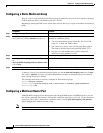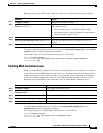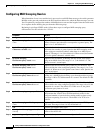
36-3
Catalyst 2960 and 2960-S Switch Software Configuration Guide
OL-8603-09
Chapter 36 Configuring IPv6 MLD Snooping
Understanding MLD Snooping
MLD Messages
MLDv1 supports three types of messages:
• Listener Queries are the equivalent of IGMPv2 queries and are either General Queries or
Multicast-Address-Specific Queries (MASQs).
• Multicast Listener Reports are the equivalent of IGMPv2 reports.
• Multicast Listener Done messages are the equivalent of IGMPv2 leave messages.
MLDv2 supports MLDv2 queries and reports, as well as MLDv1 Report and Done messages.
Message timers and state transitions resulting from messages being sent or received are the same as those
of IGMPv2 messages. MLD messages that do not have valid link-local IPv6 source addresses are ignored
by MLD routers and switches.
MLD Queries
The switch sends out MLD queries, constructs an IPv6 multicast address database, and generates MLD
group-specific and MLD group-and-source-specific queries in response to MLD Done messages. The
switch also supports report suppression, report proxying, Immediate-Leave functionality, and static IPv6
multicast MAC-address configuration.
When MLD snooping is disabled, all MLD queries are flooded in the ingress VLAN.
When MLD snooping is enabled, received MLD queries are flooded in the ingress VLAN, and a copy of
the query is sent to the CPU for processing. From the received query, MLD snooping builds the IPv6
multicast address database. It detects multicast router ports, maintains timers, sets report response time,
learns the querier IP source address for the VLAN, learns the querier port in the VLAN, and maintains
multicast-address aging.
Note When the IPv6 multicast router is a Catalyst 6500 switch and you are using extended VLANs (in the
range 1006 to 4094), IPv6 MLD snooping must be enabled on the extended VLAN on the Catalyst 6500
switch in order for the Catalyst 2960 or 2960-S switch to receive queries on the VLAN. For
normal-range VLANs (1 to 1005), it is not necessary to enable IPv6 MLD snooping on the VLAN on the
Catalyst 6500 switch.
When a group exists in the MLD snooping database, the switch responds to a group-specific query by
sending an MLDv1 report. When the group is unknown, the group-specific query is flooded to the
ingress VLAN.
When a host wants to leave a multicast group, it can send out an MLD Done message (equivalent to
IGMP Leave message). When the switch receives an MLDv1 Done message, if Immediate- Leave is not
enabled, the switch sends an MASQ to the port from which the message was received to determine if
other devices connected to the port should remain in the multicast group.
Multicast Client Aging Robustness
You can configure port membership removal from addresses based on the number of queries. A port is
removed from membership to an address only when there are no reports to the address on the port for
the configured number of queries. The default number is 2.



